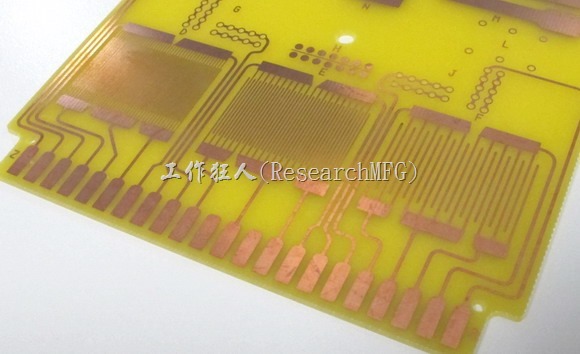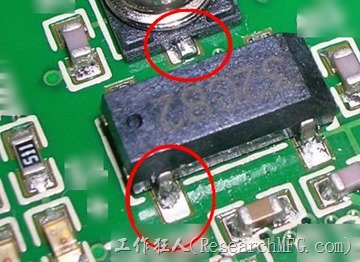
OSP (Organic Solderability Preservative) is a special chemical coating applied to the surface of copper on a PCB (Printed Circuit Board). This coating forms a thin protective film that keeps the bare copper from rusting or corroding when it’s stored. During PCB assembly, the coating can be easily removed by certain chemicals, exposing clean copper for soldering.
The OSP coating is like an invisible film, and you can’t see it easily with your eyes. Experts might use special techniques to check if it’s there. The challenge for PCB manufacturers is that OSP-finished PCBs look similar to regular bare copper boards, making it harder to inspect.
If there are any opened or defects in the OSP coating, the exposed copper could start to corrode, causing problems during assembly. While a thicker OSP coating gives better protection, it also needs stronger chemicals for soldering. So, the ideal thickness for OSP is between 0.2 to 0.5 micrometers.
The Production Flowchart of OSP (Organic Solderability Preservative)

Acid Cleaner (Degreaser):
The main purpose is to remove copper surface oxides, fingerprints, grease, and other contaminants that may appear during the pre-process, in order to achieve a clean copper surface.
Micro-etch:
Micro-etching is primarily aimed at removing more severe oxides on the copper surface and producing a uniformly bright and slightly rough copper surface. This allows the subsequent OSP film to adhere more finely and evenly. The gloss and color of the copper surface after OSP coating are positively correlated with the micro-etching solution used, as different solutions can result in varying degrees of surface roughness, which, in turn, affects the refraction and angle of light.
Acid Rinse:
The purpose of acid rinsing is to thoroughly remove any remaining substances on the copper surface after micro-etching, ensuring the copper surface is clean and ready for the next process.
OSP Coating (Organic Solderability Preservative Treatment):
A thin organic copper compound film is grown on the copper surface to protect it from oxidizing when stored in the atmosphere. The recommended OSP coating thickness is between 0.2-0.5 micrometers.
Factors Affecting OSP Coating:
- pH value of the OSP bath solution
- Concentration of the OSP bath solution
- Total acidity of the OSP bath solution
- Operating temperature
- Reaction time
After OSP coating, the water rinse process should strictly control the pH value to be above 2.1, to avoid over-acidic rinsing that may dissolve the OSP film and result in insufficient thickness.
Drying:
To ensure that the coating on the board surface and inside the holes of PCB is dry, it is suggested to use hot air blowing at 60-90°C for 30 seconds. (The required temperature and time may vary depending on the specific OSP material used.)
Advantages of OSP (Organic Solderability Preservative) Surface Treatment for PCBs:
-
Cost-effective.
-
Good solder joint strength. The solder joint strength of OSP copper base is generally better than ENIG nickel base, but it may decrease gradually over time.
-
Outdated (three or six months old) PCBs can be reprocessed with surface treatment, usually limited to one reprocessing depending on the condition of the board.
Disadvantages of OSP (Organic Solderability Preservative) Surface Treatment for PCBs:
-
OSP is a transparent film, making it difficult to measure its thickness and control it accurately. If the film is too thin, it may not protect the copper surface adequately, while if it’s too thick, it can hinder soldering.
-
For applications requiring secondary reflow, it is recommended to perform the reflow in an environment with nitrogen gas (N2) to achieve better soldering results.
-
Short shelf life: Generally, OSP film has a shelf life of up to six months after completion at the PCB factory, but some may have a shelf life of only three months. It depends on the capabilities of the PCB factory and the quality of the boards. Some boards that exceed their shelf life can be sent back to the factory to remove the old OSP coating and apply a new one. However, removing the old OSP requires using chemically corrosive agents, which may corrode the original copper surface, especially for small solder pads or fine traces, which may not be manageable. It is essential to communicate with the PCB factory to determine if surface treatment can be re-done.
-
Susceptible to acid and humidity: When used in secondary reflow soldering, it needs to be completed within a certain time frame, and generally, the results of the second reflow soldering may be inferior. It is recommended to use OSP within 24 hours after opening the package (finishing reflow). Both the first and second reflow soldering should be as short as possible, preferably within 8 or 12 hours.
-
OSP is an insulating layer, so test points on the board must be coated with solder paste to remove the original OSP film and establish contact with the test probe for electrical testing. For more information, read about ICT (In-Circuit-Test) and its pros and cons.
-
OSP boards have a copper base, and after soldering, they initially form a benign IMC (Intermetallic Compound) called Cu6Sn5. However, over time, it may gradually transform into an inferior IMC called Cu3Sn, which can affect reliability. Therefore, if OSP boards are intended for long-term use in high-temperature environments or products with an extended lifespan, it is crucial to consider the long-term reliability issues of OSP.
WorkingBear’s Personal Opinion on OSP Surface Treatment for PCBs:
In my opinion, OSP is a great choice for mass-producing consumer products because it’s cost-effective, works well for soldering when it’s fresh, and provides strong initial soldering strength. However, over time, its soldering performance may degrade as the Intermetallic Compound (IMC) formed between copper base and solder changes from good to not-so-good (Cu6Sn5 to Cu3Sn). If we could control this transition to happen after a fixed period (after the warranty period, for example), it would be even better.
On the other hand, OSP film is not the best option for small-batch or diverse products, or when we can’t accurately predict demand. If our company often keeps PCB inventory for more than six months, using OSP-treated PCBs might not be a wise choice. It’s like making a silly mistake that we should avoid.
Related Articles:









Leave a Reply